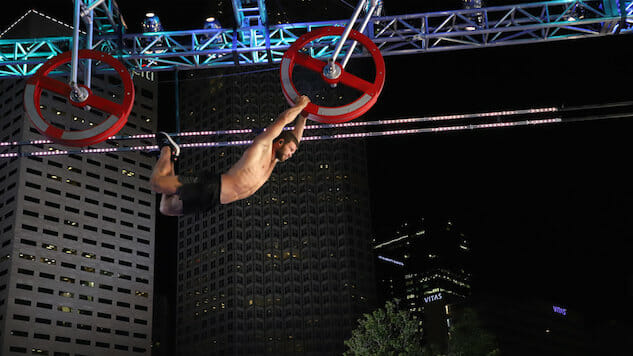American Ninja Warrior Is Building a Reality TV Legacy on the Belief in Humanity’s Ability to Be Excellent
Photo: John Parra/NBC
Competitive reality television thrives on provoking one of two reactions from its audience: “Oh, I could totally do that,” or “Oh… I could NEVER do that.”
So You Think You Can Dance? No, I do not! Not without training! I could NEVER do that. Dancing With the Stars? OK, I couldn’t do that well, but the way that disco ball of good vibes and hard training is set up, I could totally do it some. Chopped? I mean, don’t put on camera on me, but I could totally do that. Beat Bobby Flay? Look: NO ONE can do that. But… I do have a showstopping browned butter shortbread recipe, and he is weak in pastry.
Your mileage may vary on any one of those franchises, but I stand by the premise—for them and any other competitive reality series out there, most people will know instinctively within the first few minutes which camp they fall into. Either you sit rapt because you just know you could go toe-to-toe with any of the schmos that passed the audition, or you sit rapt because you can’t imagine a situation in which you could possibly accomplish the thing happening on your screen.
But then there is American Ninja Warrior, NBC’s high-flying, limit-defying, walk-on-welcoming, American community-loving version of Japan’s cultural behemoth, SASUKE, with its four-stage obstacle course that starts with simple balance steps that, man, it sure seems like anyone could do but ends in a 75-foot rope climb, which literally fewer than three American competitors have done in 9 years.
Here is the full Stage 3 + 4 run from one of them, Isaac Caldiero, who completed the climb faster than fellow Stage 4 winner, Geoff Britten, and became the only ninja in nine years to win the competition’s promised $1,000,000 prize:
Like… I could I could NEVER do that. But also, he built one of the obstacles in his parents’ backyard to train on. I have access to parents. I have access to a backyard. I have arms. If that’s not the definition of “OK…I guess???? I could?? also?? do??? that?????” then, like, what is?
And that’s American Ninja Warrior’s whole deal: Making what looks impossible possible, and convincing everyone watching—young and old, male and female, already fit, not-at-all fit, or fresh-out-of-medical-hell—that with a positive attitude, a strong support network, and (sorry) an intense amount of hard physical work, personal excellence is absolutely achievable. Sure, maybe the rest of us won’t be reaching the top of Mount Midoriyama (the majority of the professional ninjas don’t make it there), or even making it past the steps in Stage 1’s first balance obstacle, but that, the show insists, shouldn’t stop us from trying, from testing our own physical limits and seeing what personal bests we might achieve.
What American Ninja Warrior does, that is, is make the argument that anybody is capable of greatness, on American Ninja Warrior or off. And that Platonically anodyne message has resulted in an explosion of ninja-passion in millions of American living rooms, families not just watching together, but training together—and sometimes even going on to compete in a city qualifier, themselves, like “Ninja Mom” Jessica Clayton:
It’s not just the inspiring success story “packages” that make American Ninja Warrior’s argument at universal potential effective, though. It is also how relatively young the sport is (yes, despite its skeleton of boobtube spectacle, it is absolutely a sport), and how many opportunities that youth opens up that just aren’t available in legacy sports.
-

-

-

-

-

-

-

-

-

-

-

-

-

-

-

-

-

-

-

-

-

-

-

-

-

-

-

-

-

-

-

-

-

-

-

-

-

-

-

-








































